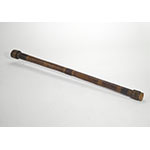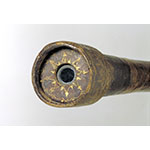Original telescope made by Galileo consisting of a main tube with separate housings at either end for the objective and the eyepiece. The tube is formed by strips of wood joined together. It is covered with red leather (which has become brown with the passage of time) with gold tooling. The plano-convex objective, with the convex side facing outward, has a diameter of 37 mm, an aperture of 15 mm, a focal length of 980 mm, and a thickness at the center of 2.0 mm. The original eyepiece was lost and was replaced in the nineteenth century by a biconcave eyepiece with a diameter of 22 mm, a thickness at the center of 1.8 mm, and a focal length of ‑47.5 mm (the negative focal length means that the lens is diverging). The instrument's magnification is 21 and its field of view 15'. It is registered in the 1704 inventory of the Uffizi Gallery as "A telescope of Galileo 1 2/3 braccia [973 mm] long in two pieces to lengthen it, covered with leather of several colors and gold tooling, with two lenses, of which the eyepiece is at an angle": the eyepiece was thus still present, but loose in its housing. By the end of the eighteenth century, it was missing. In 1611, Prince Federico Cesi, founder of the Accademia dei Lincei, suggested calling this instrument telescopio [from the Greek tēle ("far") and scopeo ("I see")].
Galileo designed ingenious accessories for the telescope's various applications. One of the most important was the micrometer, an indispensable device for measuring distances between Jupiter and its moons. Another was the helioscope, which made it possible to observe sunspots through the telescope without risking eye damage.











